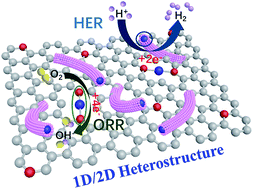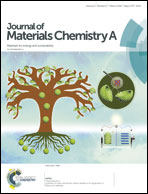Co,N-codoped nanotube/graphene 1D/2D heterostructure for efficient oxygen reduction and hydrogen evolution reactions†
Abstract
Non-precious metal and nitrogen codoped carbon catalysts have emerged as promising candidates to replace noble platinum (Pt)-based catalysts in the processes of the oxygen reduction reaction (ORR) and the hydrogen evolution reaction (HER). Herein, we use a 1D/2D hybrid strategy to synthesize a Co,N-codoped carbon nanotube (CNT)/graphene heterostructure bifunctional catalyst (Co/NCNT/NG). The Co/NCNT/NG heterostructure catalyst shows not only a positive half-wave potential of 0.85 V (versus RHE) and long-term stability for the ORR, but also a low overpotential of 123 mV at a current density of 10 mA cm−2 and ultrahigh stability in 0.5 M H2SO4 for the HER. The superior performance of the Co/NCNT/NG catalyst is attributed to the inimitable 1D/2D CNT/graphene heterostructure, in which 1D and 2D structures provide different catalytically active sites (including metallic Co, CoN2 and N–C) for the HER and ORR, respectively. Moreover, the catalyst also exhibits similar discharge performance and robust durability as an air electrode in Zn–air batteries to the Pt-based one. This work provides a new approach for the in situ synthesis of bifunctional and multifunctional catalysts by integrating 1D/2D/3D materials with different catalytically active sites into one heterostructure.

- This article is part of the themed collection: International Year of the Periodic Table : Low Dimensional Carbon Systems


 Please wait while we load your content...
Please wait while we load your content...